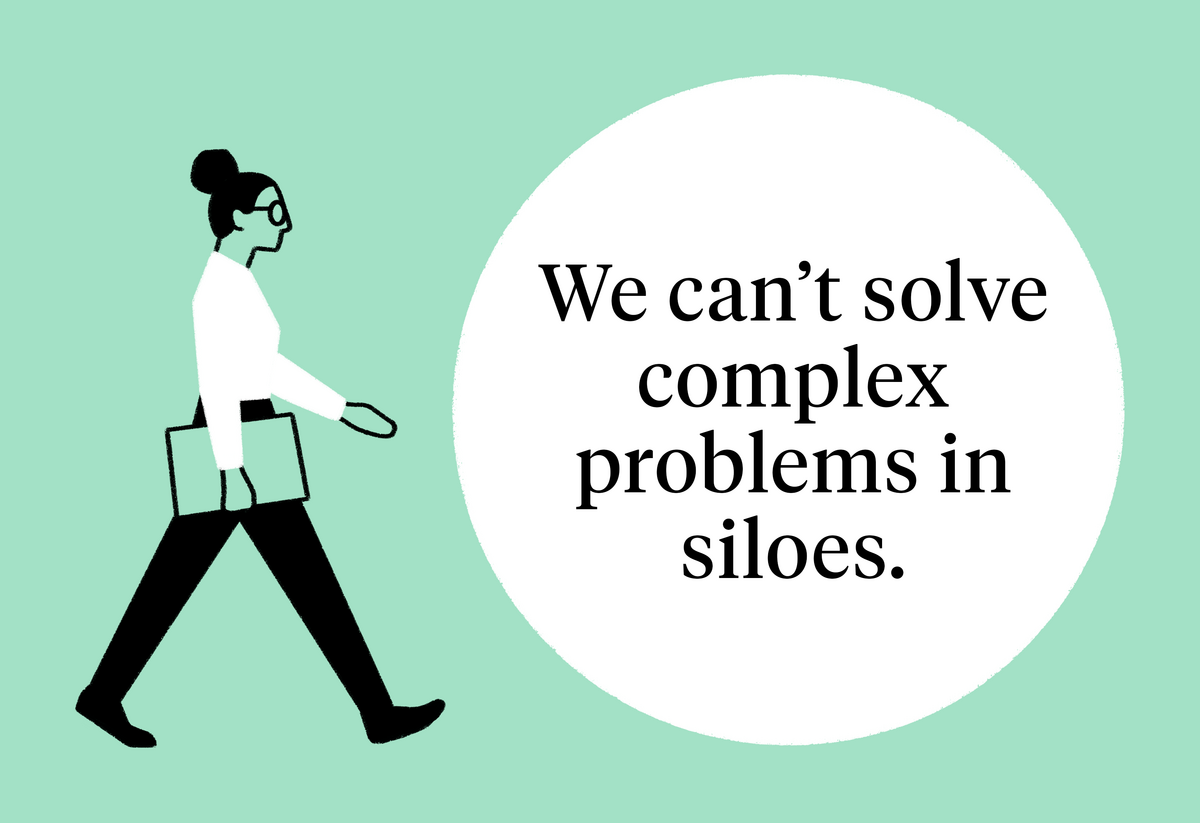Podcast Transcript
Jess LOVE: The world is a pretty complicated place. So scientists, hoping to make sense of that complexity, have historically tried to simplify things.
There are lots of ways to do this, but a common one is to run an experiment. You hold a lot of things constant, and then tweak one thing at a time to see what happens.
But over time, we’ve gotten better at collecting and analyzing data. A lot better. And in response, a new approach to making sense of complexity—a new scientific discipline, really—has started to take off. That discipline is called complexity science.
...
LOVE: When faced with a complex problem—like how the oceans will respond to climate change, or how the neurons in our brain communicate with one another, or the best way to route traffic through a quickly growing city—complexity science says, “Hey, wait a second. Instead of trying to strip out a lot of the complexity, let’s lean into it. Rather than breaking the problem into a ton of tiny little parts, and studying each of them separately, let’s look at them holistically, and see what we learn that way.”
And if this all sounds a little abstract, like something businesses don’t need to think about at all, well think again. Because markets, organizations: these are complex systems too. And business schools—OK, at least this business school—is paying attention.
You’re listening to The Insightful Leader. I’m Jess Love. Earlier this year, Kellogg announced the launch of the Ryan Institute on Complexity. Today, we’ll talk about why complexity science’s time has come, and why you should be paying attention, too.
That’s next.
...
LOVE: Before we dig into the world of complexity science, we should meet our tour guides.
Brian UZZI: Brian Uzzi is my name, I’m a professor here at Kellogg. And my background, formally, is in sociology. My specialization is in network science and increasingly in computational social science and AI.
Dashun WANG: I’m Dashun Wang. I’m also a professor here at Kellogg. I’m a recovering physicist. My main research interest right now is on the science of science, and it’s trying to take advantage of the big data and tools like AI to try to understand the secrets of invention—where breakthroughs come from.
Ben JONES: I’m Ben Jones. I’m a professor at Kellogg in the strategy department. I’m an economist by training and I think my research is a little diverse, maybe too diverse, but it’s unified around an interest in what drives human progress and also what holds back human progress.
LOVE: That’s right. A sociologist, a physicist, and an economist. But they all have something important in common, a very complex interest.
JONES: So one thing that unifies us, for example, is understanding where big breakthroughs in technology, innovation, and science come from.
LOVE: Jones, Uzzi, and Wang believe that wrapping our heads around a topic as complicated as “where big breakthroughs come from” requires a kind of interdisciplinary, “all-hands-on-deck” approach, where everyone brings their own tools and frameworks to the table.
JONES: So I’m going to come at that with a certain kind of economic frame; Brian’s going to come at that with more of a sociology frame, which is going to emphasize more network orientation, more social context and diversity, and these kinds of things; and Dashun might come at it with all sorts of physical representations of models that are from physics, but are analogous to human behavior, which is very interesting—things that wouldn’t even occur to me. And so, partly, when we work together, we are able to open up our conceptual orientations and come at a question in a more novel way because we can listen to each other and find new and broader ways of thinking.
LOVE: I had a chance to speak with these researchers about what they hope complexity science can teach us about the nature of innovation or any number of other topics. But before getting too deep into that conversation, I wanted to understand: Why is it so important to look at a system as a whole, instead of breaking it into parts?
WANG: The canonical example is to think about the flock of birds. So if you look at a flock of birds, you realize they go together almost like an organism, but there is no middle manager in that flock. There is no CEO, but they managed to—each individual bird—they just look at each other. But as a whole, they exhibit a kind of property that no individual bird can do, right? Individual birds actually, unfortunately, can achieve very little. But as a flock, that gives them a competitive advantage, actually. Then they can go after food sources that otherwise individuals couldn’t.
LOVE: The point here is that you can’t really understand how a flock of birds behaves by investigating how each bird behaves individually. You need to understand the relationships between the birds, and how those relationships change as the birds move through the sky, or hit bad weather, or try to defend themselves against a predator. In other words, you need to think about the entire flock as a system.
But this raises another question. So I asked it!
LOVE: How do you decide what’s in the system and what isn’t?
UZZI: That’s one of those questions. It’s like every scientist has got a thing that they focus on, but no one can define it. Like, sociologists care about status, but we’ll never define it for you; economists love costs, but ask them what a cost is, and they can’t really say this sort of thing; and in complex systems, the boundary of the system is always an issue because it’s somewhat subjective as to where you want to define it. So if you’re looking at a rock and roll band, is it the five people in the group? Is it the group, plus the producer on the album, plus the record label that markets It? You can open and close the boundaries and see different things, depending on where you essentially begin and end your relationships. So I wouldn’t say there’s a fixed rule about it, which also gives it flexibility in being able to explain a lot of stuff.
WANG: Or another way I look at it is: everything’s a system, it’s just a different scale. A team is a system of different minds working together. Every mind, every brain’s a system. It’s billions of neurons. Actually, it’s so complex, we don’t even know how many billions. Estimates are 10 to 100 billions of neurons in my brain that are firing.
JONES: When you say what do you leave in, what do you leave out: you approach a research question as a researcher. You don’t just have a completely atheoretic idea. You have some conceptualization and that’s going to guide what you look at to measure, and then with those measurements, what you study. And of course it’s an imperfect first guess, but of course we are always sort of stumbling around in the dark as researchers, trying to push the frontier of knowledge. And we may get it right, we may get it wrong, but we’re always working with some kind of conceptual framework to start with that gives us some guide about what do you include, what do you not include.
LOVE: This question—what you put in the system and what you leave out—is why getting an interdisciplinary team together to study complicated, dynamic problems is so important. Otherwise, you don’t even know what you don’t know.
But, let’s get really concrete here. What can this “systems approach” tell us about innovation, or collaboration, or some of the other kinds of questions that businesses would care about?
Here’s Ben Jones again.
JONES: Imagine you’re running your business and your R&D teams, and you’ve got a bunch of talent, and your R&D staff, and you’re thinking about, “how do I build these individuals into teams to tackle some technology innovation that could be great for the firm, could be great for society?” Is an R&D team like a string quartet or is it more like the copilots in the cockpit of a plane? Now, if you think about this, if you had four pilots and two planes and you had two really, really good pilots and you had two very sketchy pilots, would you want to put the sketchy pilots together or would you want to split them up with the good pilots?
Pause. Podcast listeners, consider this question. You would want to put a good pilot in each plane. You would not want to put the sketchy pilots together because you want to make sure that each plane has at least one good pilot, right? Because effectively the quality of the plane flying is going to depend on the best person in the cockpit. And so you don’t want to have only bad people in the cockpit. So that’d be sort of one way to—that’s what American Airlines should be doing. But if you were a string quartet, let’s say I’m trying to build string quartets. Do I want to spread my sketchy musicians around? I do not. Because one sketchy member on the quartet is going to ruin the whole sound. If someone’s playing off time or off tune, it’s going to ruin the whole effect. So what you’d actually like to do is isolate problem cases and you want your best people working together.
Okay, now go to an R&D team in an organization. You’ve got a couple of people who are really great, they have really great ideas. Do you split them up? They can both drive their own team, like the pilots. Or, do you want to put them together because you don’t want to saddle them with someone playing out of tune? So we studied this. And how would you study that? Well, it gets back to networks and data. You have to look at large-scale data and watch what happens as people move around from different teams. You see how they perform in different contexts. And by doing that, you can learn from—whether it’s scientists or inventors—what’s the way to organize your R&D teams? It turns out that R&D teams look a lot like string quartets, not like pilots. So, in other words, you actually don’t want to spread your best people around in independent teams. You’d rather have them work together. And this gets back to people being specialized. And so really it’s kind of like a quartet. If the cellist is playing badly, the whole thing fails. Similarly, in a modern R&D situation, people are bringing specialized skills into teams, and if you have a weak link on one of the specialists, they can cause the whole project to be defeated. And so these are the kinds of lessons you can get out of it, from thinking about relationships that can be really directive, I think, for really important decisions for firms.
LOVE: Of course, we’ve been trying to figure out the best way to run teams and businesses for a long time. But Wang says there are two big reasons complexity science is poised to make major headway right now.
WANG: If we boil down to two major factors, it’s data and tools. I think, on one hand, there’s this large amount of data that captures many aspects of business or all kinds of human behavior, and this kind of data has now become available in a way that’s hard to imagine 10 years ago or 20 years ago. So there’s this unprecedented level of access that we have to data. But at the same time, I think what is often overlooked is the availability of tools that can help us make sense of this data. And these tools range from complexity science and networks as a tool, and also to large language models or AI as a tool. You can then borrow these kinds of tools to ask very fundamental social-science questions.
LOVE: The social sciences are going to be a big focus of the Ryan Institute, the new interdisciplinary research hub that will be co-led by Jones, Wang, and Uzzi. And the social sciences are kind of a new direction for the study of complexity.
WANG: Yeah. So complexity science has won a Nobel Prize in physics, but applying it to business and social science, we’re just at the beginning. We’re really just scratching the surface.
LOVE: And to go along with this new approach, they want to try a totally different way of working.
WANG: So traditionally you think social-science research has been individual faculty members working in their offices, for example. But one of the things we’re hoping to do with the Ryan Institute is to bring this lab model—which is a model of research that’s been time-tested in some of the most rigorous scientific disciplines in the world, which is the hard sciences—and bring that kind of lab model into social sciences. So then, hopefully, this will enable faculty members at the school, as well as in the university, to establish new collaborations that will help us scale faculty’s time, will help us work together on bigger problems, and attack those problems faster.
LOVE: And getting better at addressing big problems, fast, is really important. It’s also hard—maybe harder than it’s ever been before. Why? Jones says this has to do with how much headway science has already made, something he calls “the burden of knowledge.”
JONES: So the idea of the burden of knowledge is really very simple. It’s that in every generation today—100 years ago, 200 years ago—people are born with empty minds, the same empty minds. But you’re born into a world today where we have so much more extant knowledge, technical knowledge, scientific knowledge about how to do things. And so you just can’t be an expert as easily and as broadly as you were in the past. The Wright brothers were two brothers who produced the first airplane, and they’re both considered leading aeronauts of their time. They’re sort of conceiving of the plane, they’re designing it, they’re building it, they’re even flying it. And that’s just two people and they’re able to make this work. But a modern airframe, like an Airbus or a 787 from Boeing, we’re talking just the jet engines are 30 different PhD level disciplines, and that’s just the jet engine.
LOVE: Uzzi agrees.
UZZI: As scientists and people trained to solve problems see a smaller piece of the world, they’re also equipped to only solve a smaller piece of the world. But the problems have gotten bigger, and more complex, and global in nature. And the only way to make it work is you’ve got to put people back together in a network. And the Ryan Institute is an incredible opportunity to be part of trying to define that future.
[CREDITS]
LOVE: This episode of The Insightful Leader was produced by Andrew Meriwether, Susie Allen, and me, Jess Love. It was edited by Jess Love, Laura Pavin, Susie Allen, Fred Schmalz, Maja Kos, and Blake Goble. It was mixed by Andrew Meriwether. Special thanks to Ben Jones, Dashun Wang, and Brian Uzzi. Want more The Insightful Leader episodes? You can find us on iTunes, Spotify, or our website: insight.kellogg.northwestern.edu. We’ll be back in a couple weeks with another episode of The Insightful Leader Podcast.



